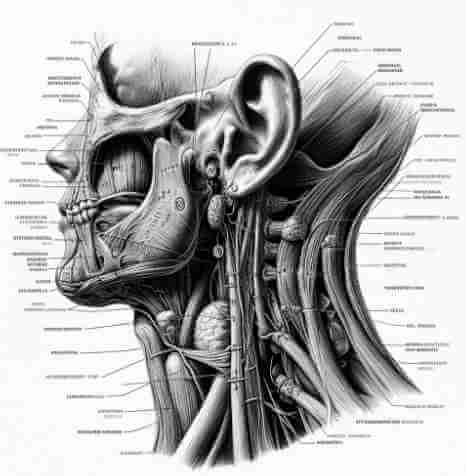Quick Overview
The greater auricular nerve (GAN) is a superficial cutaneous nerve that arises from the cervical plexus. It is the largest ascending branch of the cervical plexus and provides sensory innervation to the skin of the auricle (external ear), parotid gland, and mastoid process.

Table of Contents
Anatomy of Greater Auricular Nerve
The greater auricular nerve finds its origins within the cervical plexus, specifically emerging from the ventral rami of C2 and C3 spinal nerves. It begins its journey deep within the layers of the neck and proceeds to extend toward the external ear, specifically the auricle.
This nerve showcases a distinctive branching pattern. It comprises an anterior branch, closely aligned with the facial nerve as it approaches the parotid gland, and a posterior branch, extending towards the mastoid process.
When the GAN approaches the inferior pole of the parotid gland, it divides into anterior and posterior terminal branches. The anterior branch supplies the skin of the parotid gland and the anterior portion of the auricle, while the posterior branch supplies the skin of the posterior portion of the auricle and the mastoid process.
| Nerve | Description |
| Origin | Cervical plexus |
| Branches | Anterior branch, Posterior branch |
| Supply | Skin of the parotid gland and the anterior and posterior portion of the auricle and mastoid process. |
Branches and Supply
- Anterior branch: This branch supplies the skin of the parotid gland and the anterior portion of the auricle. It also communicates with the facial nerve.
- Posterior branch: This branch supplies the skin of the posterior portion of the auricle and the mastoid process. It also communicates with the lesser occipital nerve and the auricular branch of the vagus nerve.
Function and Innervation
The primary function of the greater auricular nerve is to provide sensory innervation to the regions it traverses. This includes the skin of the neck, the parotid gland, and the mastoid process.
The anterior branch is instrumental in the innervation of the parotid gland and its adjacent areas, playing a crucial role in the overall function of this salivary gland.
The posterior branch, on the other hand, is responsible for sensory input from the mastoid process, which is essential for spatial awareness and protective reflexes.
Clinical Implications
- Impingement: Impingement of the GAN can lead to a spectrum of symptoms, including headaches, neuralgia, and even migraines. These conditions typically arise due to compression or irritation of the nerve, often resulting from inflammation or trauma in the neck or ear region. Accurate diagnosis and targeted management are essential to alleviate these often debilitating symptoms.
- Perineural Tumor Spread: The greater auricular nerve holds significant diagnostic importance in the realm of medical imaging. It serves as a potential conduit for tumor spread, especially in cases of malignancies affecting the parotid gland. CT scans and MR imaging are indispensable tools for identifying the extent of tumor extension along the neural margins of this nerve. Timely recognition and diagnosis are paramount for planning effective treatment strategies.
- Surgical Considerations: Surgeons performing procedures involving the neck or parotid gland, such as parotidectomy, must exercise great care when dealing with this nerve. Minimizing damage to this nerve during surgery is critical to preserving sensory function and minimizing postoperative complications, including the development of Frey’s syndrome.
Question
1. What is a Greater Auricular Nerve Block?
A Greater Auricular Nerve Block is a medical procedure in which a local anesthetic is injected near the greater auricular nerve to temporarily block its sensation. This can be done for diagnostic or therapeutic purposes, such as managing pain or performing minor surgical procedures in the ear, neck, or parotid region.
2. What Are the Common Indications for a Greater Auricular Nerve Block?
A Greater Auricular Nerve Block is often used to manage pain and discomfort associated with conditions like ear infections, neck surgeries, or chronic headaches that may be attributed to the greater auricular nerve’s sensitivity.
3. What Can Cause Greater Auricular Nerve Pain?
Greater Auricular Nerve Pain can result from various factors, including injury, inflammation, impingement, or compression of the greater auricular nerve. Medical conditions such as ear infections or surgical procedures in the neck area can also lead to this type of pain.
4. What Are the Symptoms of Greater Auricular Nerve Numbness?
Greater Auricular Nerve Numbness typically presents as a loss of sensation in the areas it innervates, which include the skin of the ear, neck, and parotid region. Patients may experience tingling, decreased sensitivity, or a “pins and needles” sensation in these areas.
5. How Can Greater Auricular Nerve Injuries Occur?
Greater Auricular Nerve Injuries can happen due to trauma, surgical complications, or medical procedures involving the neck or parotid region. Accidental damage to the nerve during surgery or an injury can lead to symptoms such as pain, numbness, or sensory changes.
6. What is Greater Auricular Nerve Block Ultrasound, and How Does It Work?
Greater Auricular Nerve Block Ultrasound is a technique that uses ultrasound imaging to guide the precise placement of a needle for the nerve block procedure. It allows healthcare providers to visualize the nerve and surrounding structures in real-time, enhancing the accuracy and safety of the block. This approach can result in more effective pain relief and reduced risk of complications.
